Today, we're talking about Cozonac, the Romanian sweet bread with walnuts that is a staple for Christmas and Easter. It's a simple yet delightful combo of fluffy bread and sweet walnut filling, bringing a piece of Romanian tradition right to your kitchen. So, grab your apron, and let's get baking and chatting about this cozy, delicious bread. Ready to make your kitchen smell amazing?

Jump to:
- ❓ What is this Sweet Bread with Walnuts
- 🔄Variations of the bread by country
- 👵My grandmother's way of making cozonac
- 💡Expert Tips on Baking This Sweet Bread with Walnuts
- 📝 Key Ingredients
- 🔄Variations for the Cozonac fillings
- 👩🍳How To Make Sweet Bread with Walnuts
- ❄️ How to store this sweet bread with walnuts
- 🍽️How to serve
- 🙋♀️ Sweet Bread With Walnuts (Cozonac) Faqs
- 🇷🇴 More Romanian Recipes To Love
- 📖 Recipe
- 💬 Comments
❓ What is this Sweet Bread with Walnuts
Romanian Sweet Bread with Walnuts, or "Cozonac," is a traditional, delicious treat, especially popular during holidays like Christmas and Easter in Romania and other Eastern European countries. It's a rich, sweet yeast bread, kind of similar to a brioche, but with its own unique twists.
The dough for Cozonac is made with flour, eggs, milk, sugar, and butter(sometimes oil), giving it a soft, tender texture. The real star of the show is the filling: a generous mix of ground walnuts, sugar, and sometimes cocoa or rum rolled inside the dough. Some variations include raisins, citrus zest, or Turkish delight bits for extra flavor.
After it's baked, Cozonac has a golden-brown crust, a soft, fluffy interior, and swirls of that nutty, sweet filling in every slice. It's often served in thick slices, perfect with a cup of coffee or tea. It's not just a dessert; it's a piece of cultural heritage, full of flavor and tradition.
Making Cozonac can be a bit of a project, with the kneading and rising of the dough, but it's definitely worth the effort for that special, homemade taste.
🔄Variations of the bread by country
In every European country, festive breads are a holiday staple, from Portugal's Bolo Rei to Spain's Roscón de Reyes, England's Christmas pudding, Italy's Panettone, Greece's Tsoureki, Slovenia's Potica, to Germany's Stollen. These holidays aren't complete without them.
Romania's version, a rich yeast bread similar to Italy's Panettone but denser, often features a delicious filling, making it a unique and beloved holiday treat.
Growing up, this bread was a holiday staple for me, gracing our table every Christmas and Easter. Today, it's still a household favorite. If you're not baking it yourself, chances are a grandmother, mother, or aunt is keeping the tradition alive. And if not, no worries – around the holidays, you'll find this festive bread in every bakery.
👵My grandmother's way of making cozonac
In every Romanian kitchen, you'll find a different twist on Cozonac. It's like our own little culinary fingerprint, varying from one region to another. Sure, we might playfully argue about whose version is the real deal, but the basics are pretty similar. It's all about how many eggs you use, how sweet you like it, and what you're in the mood to stuff it with.
We Romanians love keeping our traditions alive, and whipping up Cozonac for the holidays is a big deal for us. It's not just about the bread, though. Come Easter, you might also find Pasca on the table, a sweet, round bread hugged by a ring of creamy Farmer cheese and dotted with raisins.
Now, for this post, I'm going back to basics with a classic walnut-filled Cozonac. This is the stuff of childhood memories, the kind my grandma used to make in big batches every Christmas and Easter. It was almost ceremonial, her baking process, and she was pretty strict about how it was done.
And here's the beautiful part: Cozonac wasn't just for us. Grandma used to gift it too. In our Orthodox faith, sharing food is a way of remembering those who've passed and helping those who are less fortunate, especially during the holidays.
She'd put together these plates of holiday goodies – a slice of Cozonac, some stuffed cabbage rolls (a Christmas must), meatballs, Feta, salami, homemade sausages, delicious bread, cookies, and whatever else she whipped up. A glass of wine was always there, too, a little cheer for the holidays. It was her way of spreading some warmth and joy, making the festive season a bit brighter for those who needed it most.
💡Expert Tips on Baking This Sweet Bread with Walnuts
- Overcoming Baking Hesitation: Don't be daunted by Cozonac. I mastered it when I couldn't find it in U.S. stores, so you can too!
- Efficiency in Kneading: While time-consuming, using a mixer like KitchenAid can simplify the process, unlike the hand-kneading my grandma used to do.
- Select Quality Ingredients: Opt for the best you can afford. In my kitchen, I prefer organic flour, eggs, and milk.
- Precision in Measurement: A kitchen scale is essential. Weighing ingredients ensures consistency and accuracy in baking.
- Room Temperature Matters: Ingredients like eggs, butter, and flour should be at room temperature for best results.
- Preparation is Key: Organize all ingredients on the counter before starting to avoid mid-baking hassles.
- Understanding Dough Rising: Know your kitchen's temperature. At 72°F/22°C, the dough rises in 90 minutes; cooler temps (66-67°F/18-19°C) may need 2-3 hours, while warmer (76-77°F/25°C) speeds it up to about an hour. In the fridge (35-40°F/2-6°C), it rises overnight in 12 hours.
- Balance Sugar and Butter: Excess sugar and butter can delay rising and affect bread texture. They're key to flavor but balance them to maintain the bread's lightness.
📝 Key Ingredients
Here is a visual display of the ingredients. Let's take a closer look at them. For the dough, you will need the following:

You will also need:
- 1 egg beaten for brushing the loaves
- 2-3 tablespoons oil for oiling the table surface and the bowl
For the walnut filling, you will need the following:

🔄Variations for the Cozonac fillings
When it comes to Cozonac, a Romanian sweet bread, there are numerous filling options that add a delightful variety to this traditional treat. Here are some examples:
- Poppy Seed Filling: Another popular filling is made from poppy seeds, often sweetened and sometimes combined with milk or cream to create a paste-like consistency.
- Chocolate or Cocoa Fillings: For chocolate lovers, a chocolate or cocoa filling, sometimes enriched with butter, can be a decadent option.
- Rahat (Turkish Delight): This is a sweet, chewy filling made from starch and sugar, often flavored with rosewater or lemon.
- Dried Fruits and Raisins: Raisins, either on their own or soaked in rum, as well as other dried fruits like apricots, orange peel, etc, can be used to add sweetness and texture.
- Cheese Fillings: Soft cheeses like ricotta or farmer's cheese, sweetened and sometimes combined with citrus zest or vanilla, offer a creamy and rich filling option.
- Combination Fillings: Some recipes use a combination of these fillings like a layer of nut filling and a layer of poppy seed or chocolate filling, to create a more complex flavor profile.
👩🍳How To Make Sweet Bread with Walnuts
Prepare the dough:
Measure ¼ rum and place the raisins into the bowl. Set aside until you are ready to make the filling.
Make the Starter:
Step 1. Warm up the milk to 110F/44C, add the sugar, and mix to dissolve. Add the yeast and set it aside in a warm, draught-free place for 5 minutes or until frothy. (Image 1 and 2)
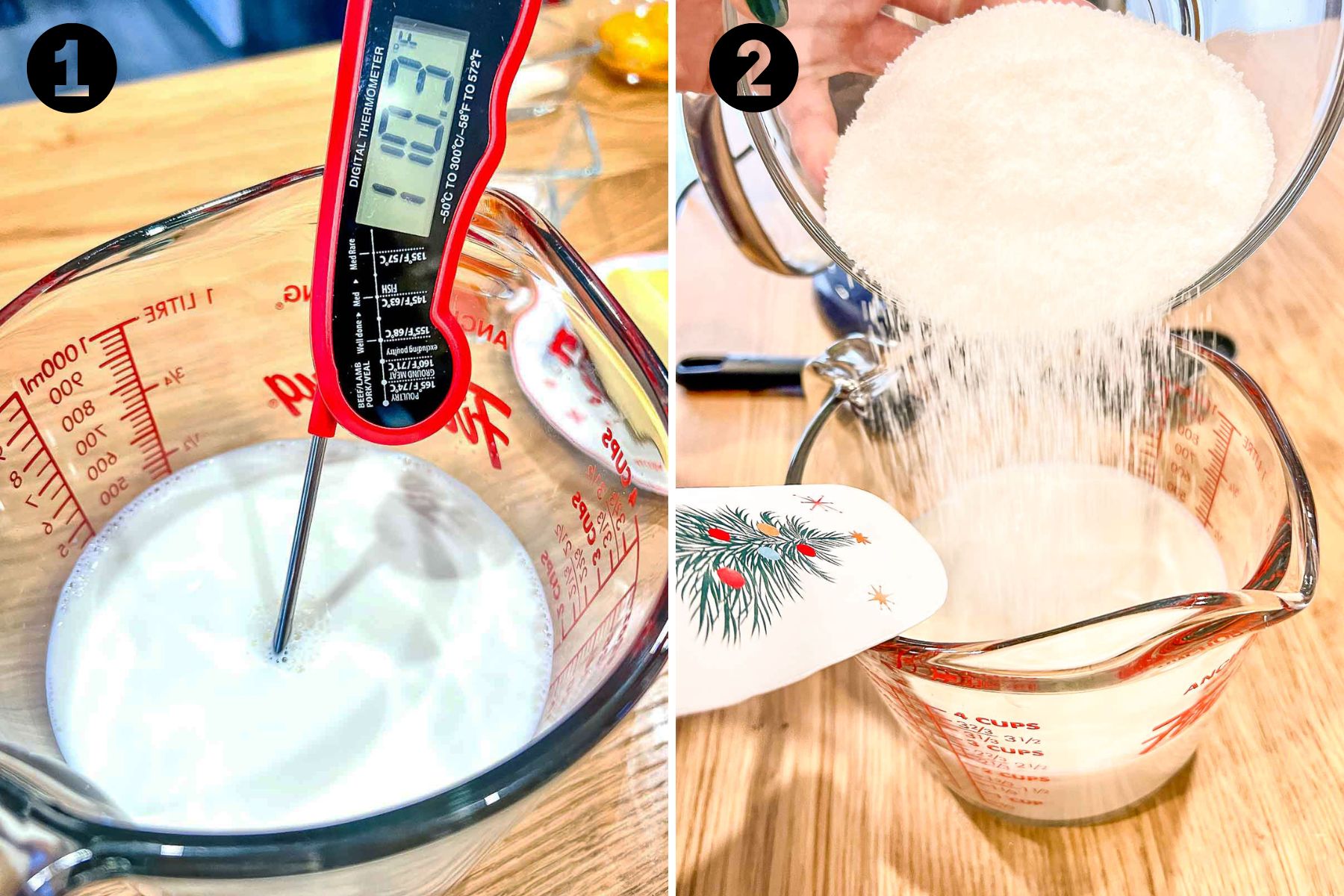
Step 2. Add the lemon rind and vanilla. (Image 3 and 4)
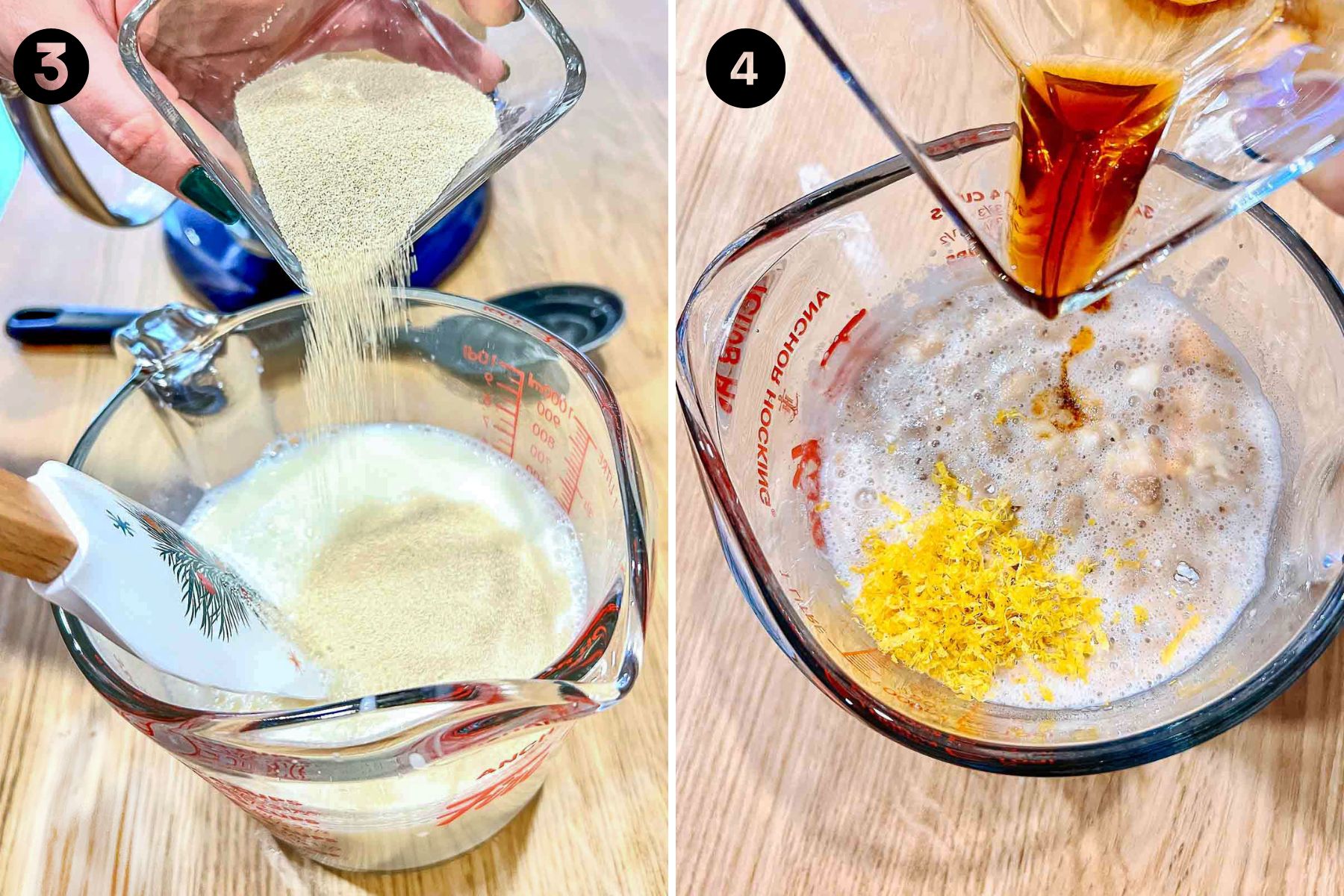
Step 3. Separate the eggs. For the dough, we will use only the yolks. (The egg white will be used to make the filling.) In a small bowl, mix yolks with the salt. Salt is essential in baking. It enhances the taste of the final product. (Images 5 and 6)
Also, in this case, the salt intensifies the color of the yolks, and the bread will have a slightly yellow, beautiful color. Set aside.
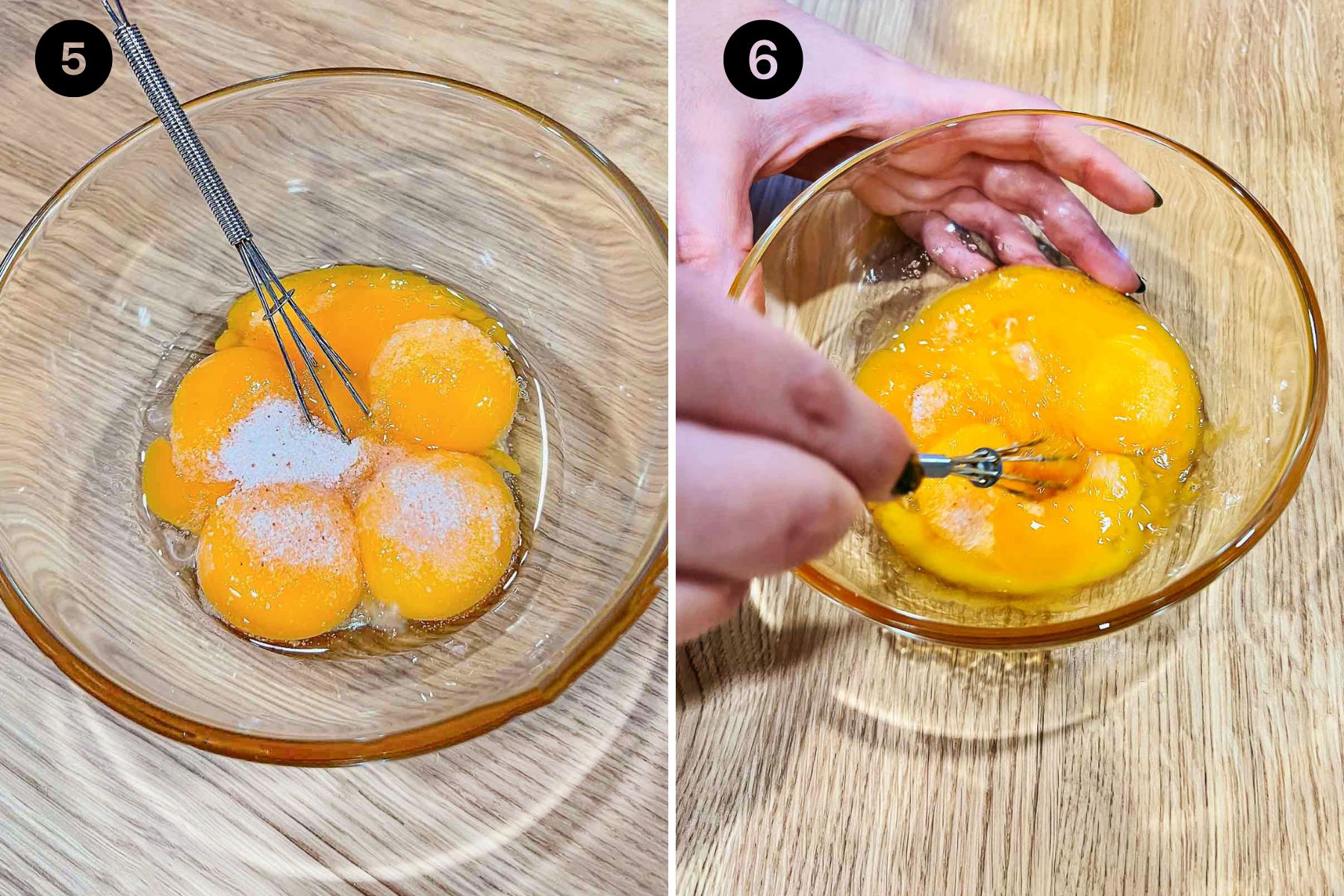
Step 4. Meanwhile, sift the flour and place it in a bowl of a stand mixer fitted with a dough hook. Start the mixer on low speed and add egg yolks. (Images 7 and 8)
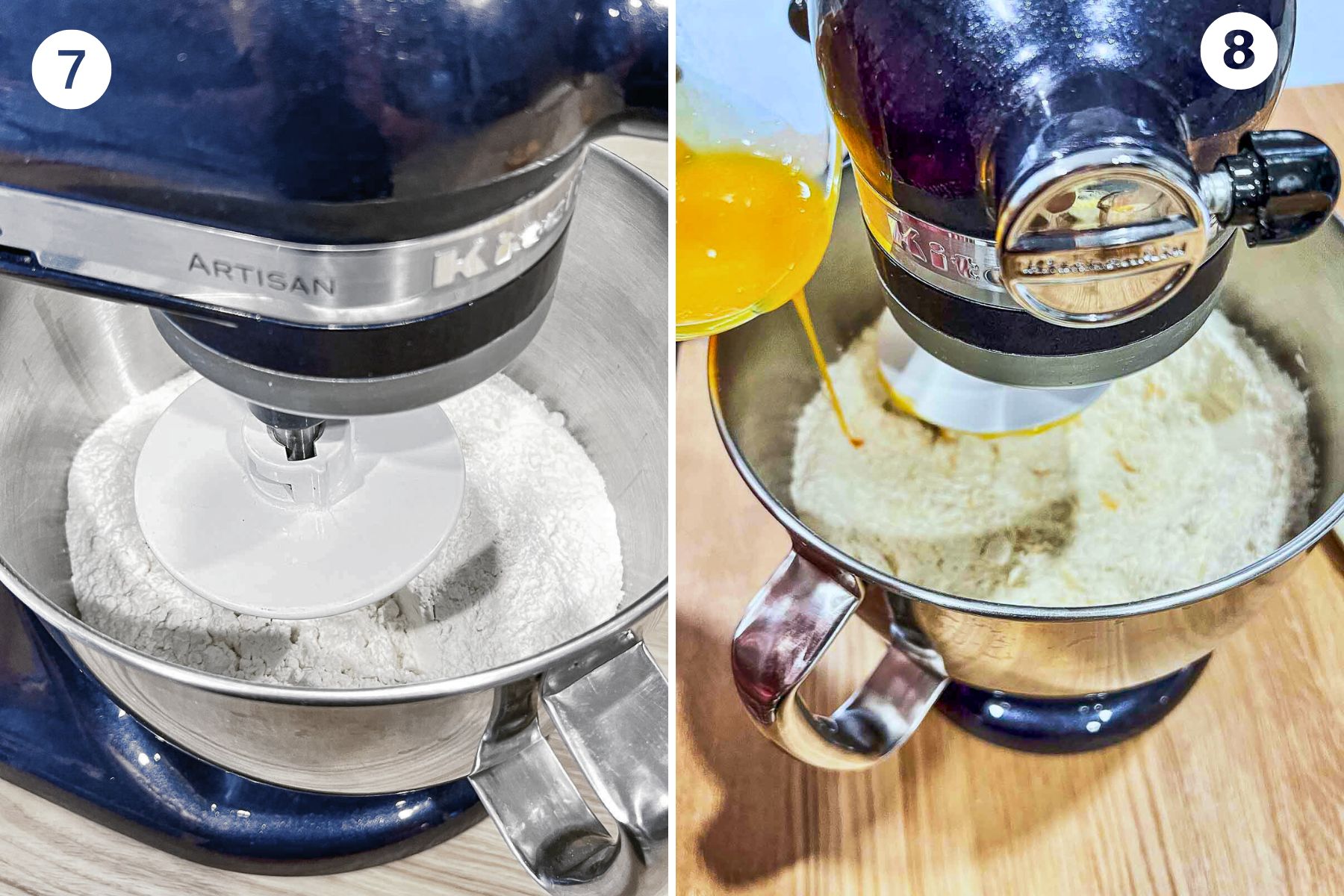
Step 5. Mix slowly while you start adding the milk mixture. You will obtain a very soft, sticky dough. Continue to mix while you add the soft butter, little by little. Continue to knead at low speed for 6-8 minutes or until the dough is smooth, elastic, and not sticky anymore. (Images 9 and 10)
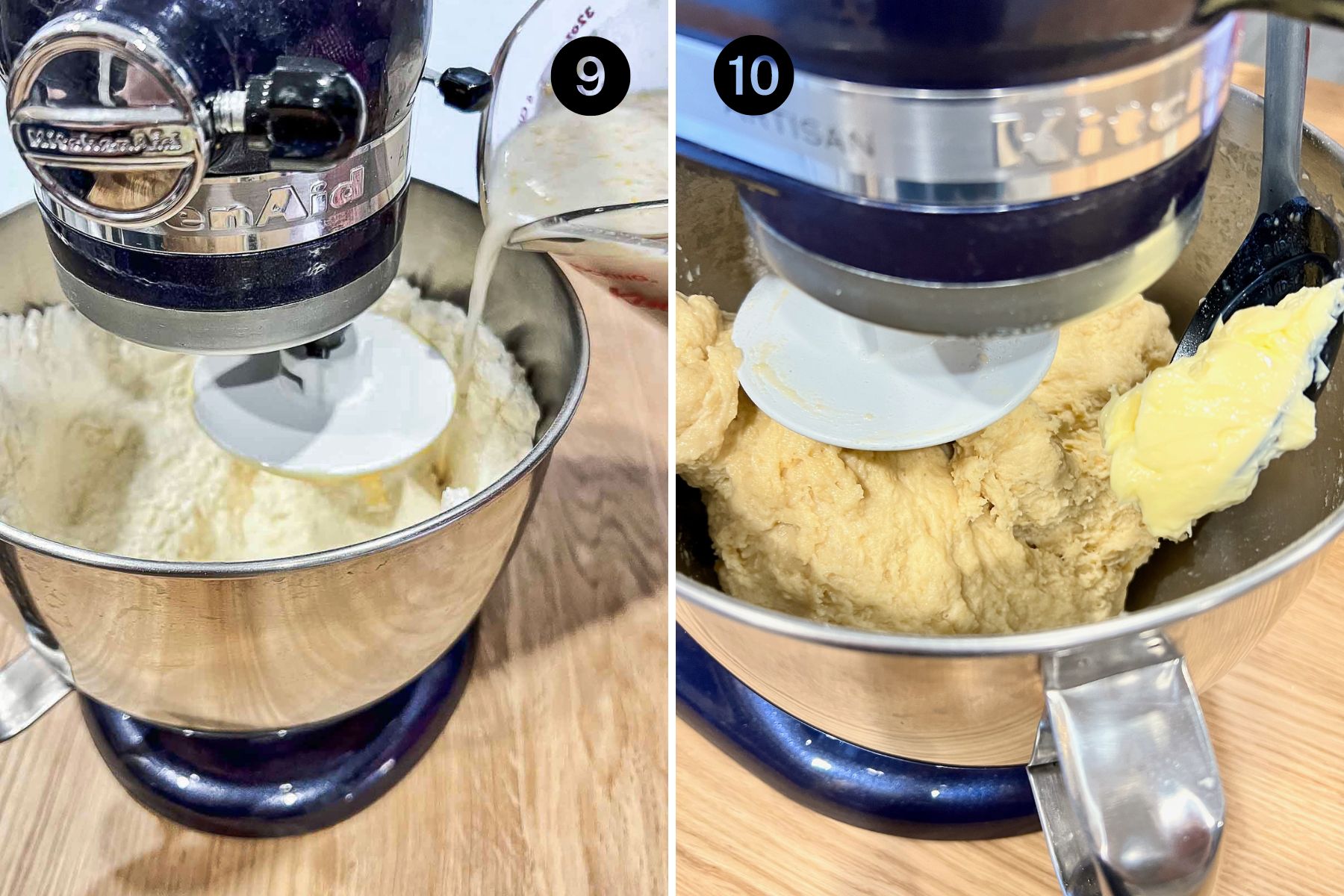
Tip: If the mixer gets too hot, stop and let cool for 5-10 minutes, then knead again until you obtain the elastic dough.
Step 6. Lightly grease a medium bowl with a little bit of oil, add the dough, and turn to coat the dough in the oil. Cover with plastic wrap and set aside in a warm, draught-free place for 1 hour or until doubled in size. (according to the temperature in your kitchen, it might take longer)
Prepare the filling:
Beat the egg whites frothy, then add the sugar and continue to beat to a soft peak. Fold the ground walnuts and the mixture of raisins and rum gently. (Images 1 and 2)

Assemble the bread.
Step 1. Brush four loaf pans with melted butter to grease. Punch the center of the dough down with your fist and turn it onto a lightly oiled surface. Knead for 1-2 minutes or until reduced to its original volume.
Step 2. Divide the dough into 4 equal portions. Use a lightly oiled rolling pin to roll out a dough portion to an 8x10 inches(20 cm x 25 cm) rectangle.
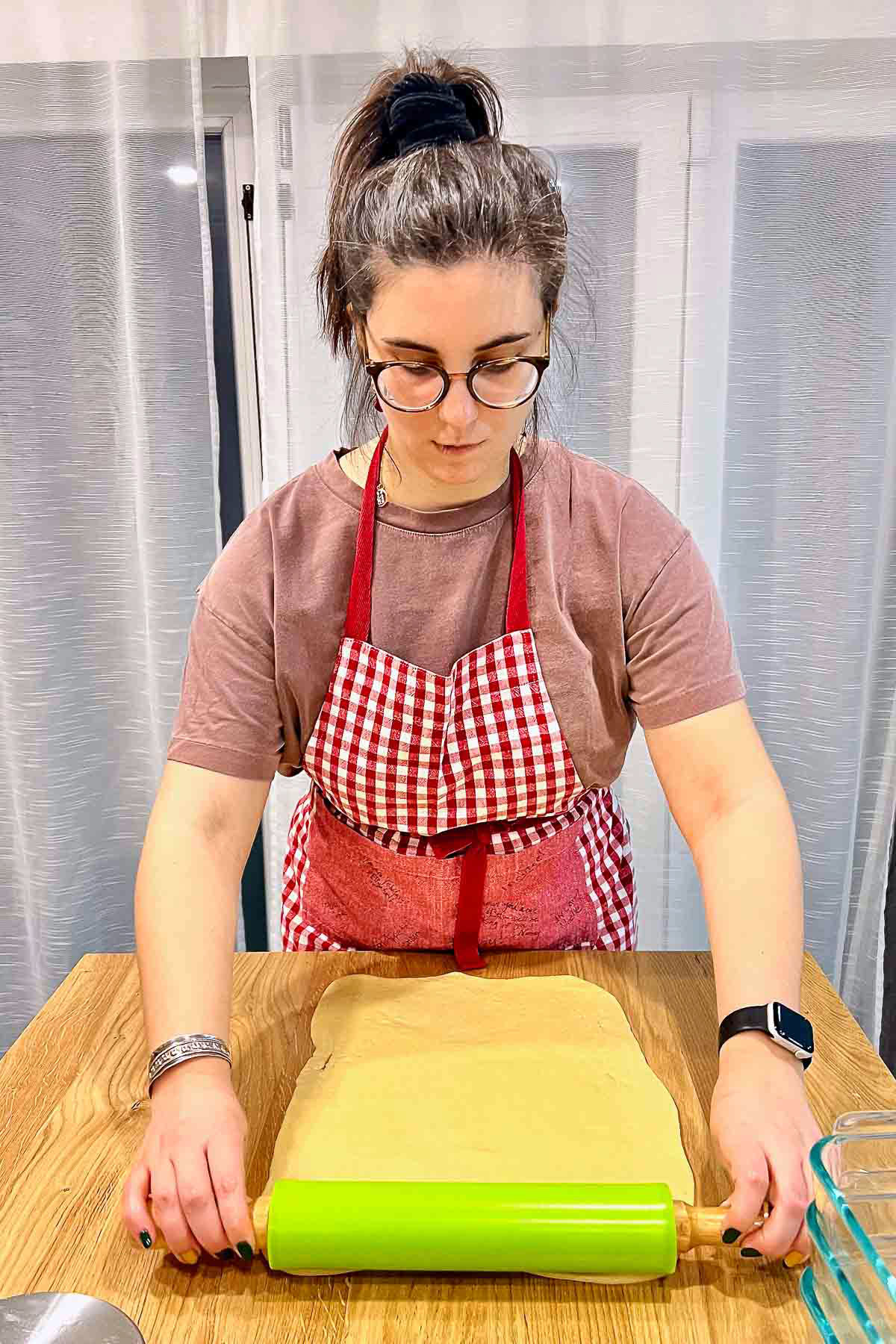
(My daughter loves doing this part every year.)
Step 3. Sprinkle a quarter of the filling evenly over the dough. Starting from a long side, roll up the dough to form a log and enclose the filling. Repeat with the remaining dough portions and filling.(Image 3 and 4)
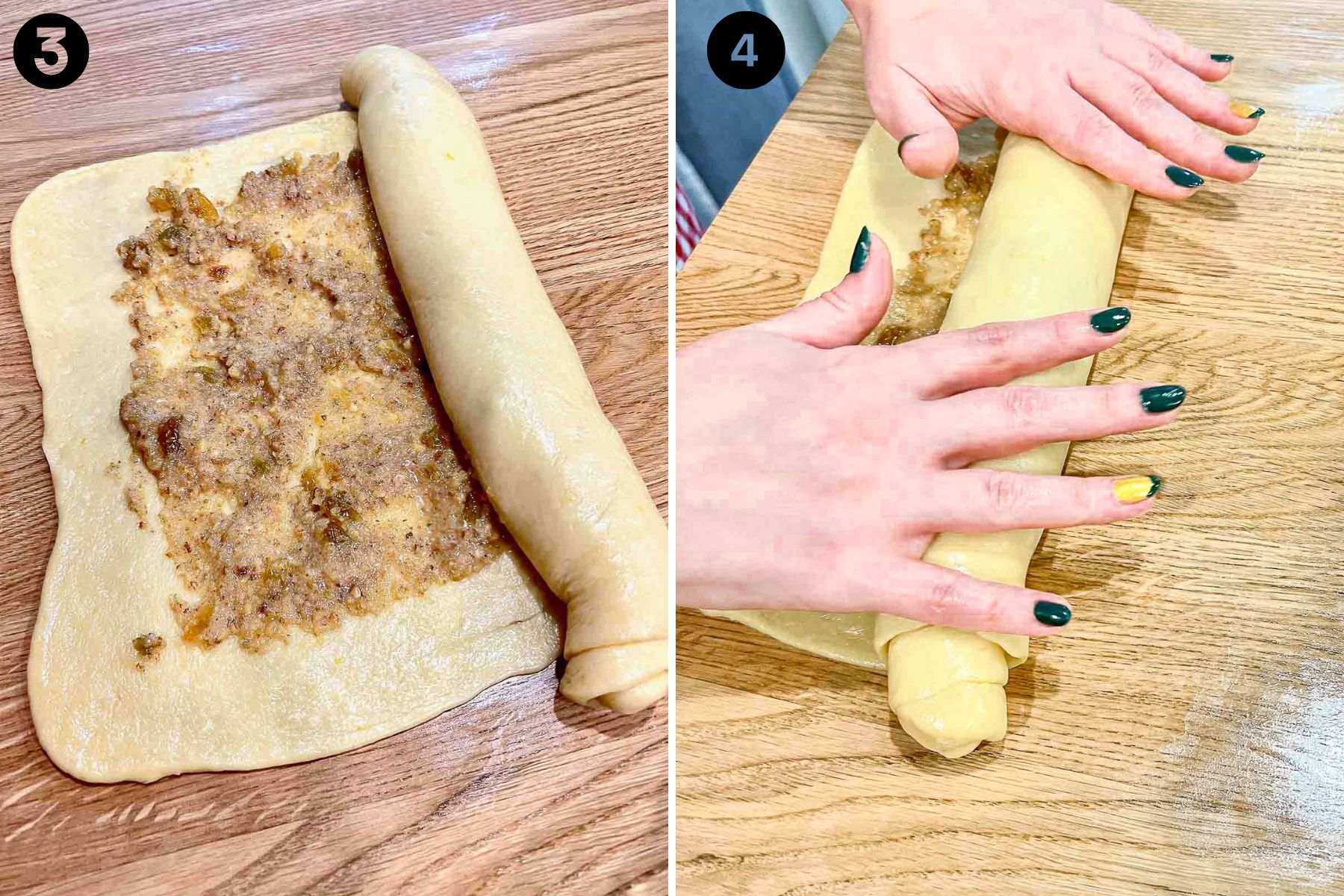
Step 4. Place each log into a 9x5-inch bread pan, or if you want to use the traditional Romanian size, use these baking pans that are extra long and skinnier. Cover with a slightly damp kitchen towel and set aside in a warm place for 1 hour or until almost doubled in size.

Step 5. Preheat the oven to 350F/180C.
Step 6. Brush the tops of the loaves with the whisked egg and sprinkle with the raw sugar. Bake for 20 minutes.
Step 7. Reduce the temperature to 330F/170C and bake for a further 30 minutes or until cooked through and the loaves sound hollow when tapped on the top.
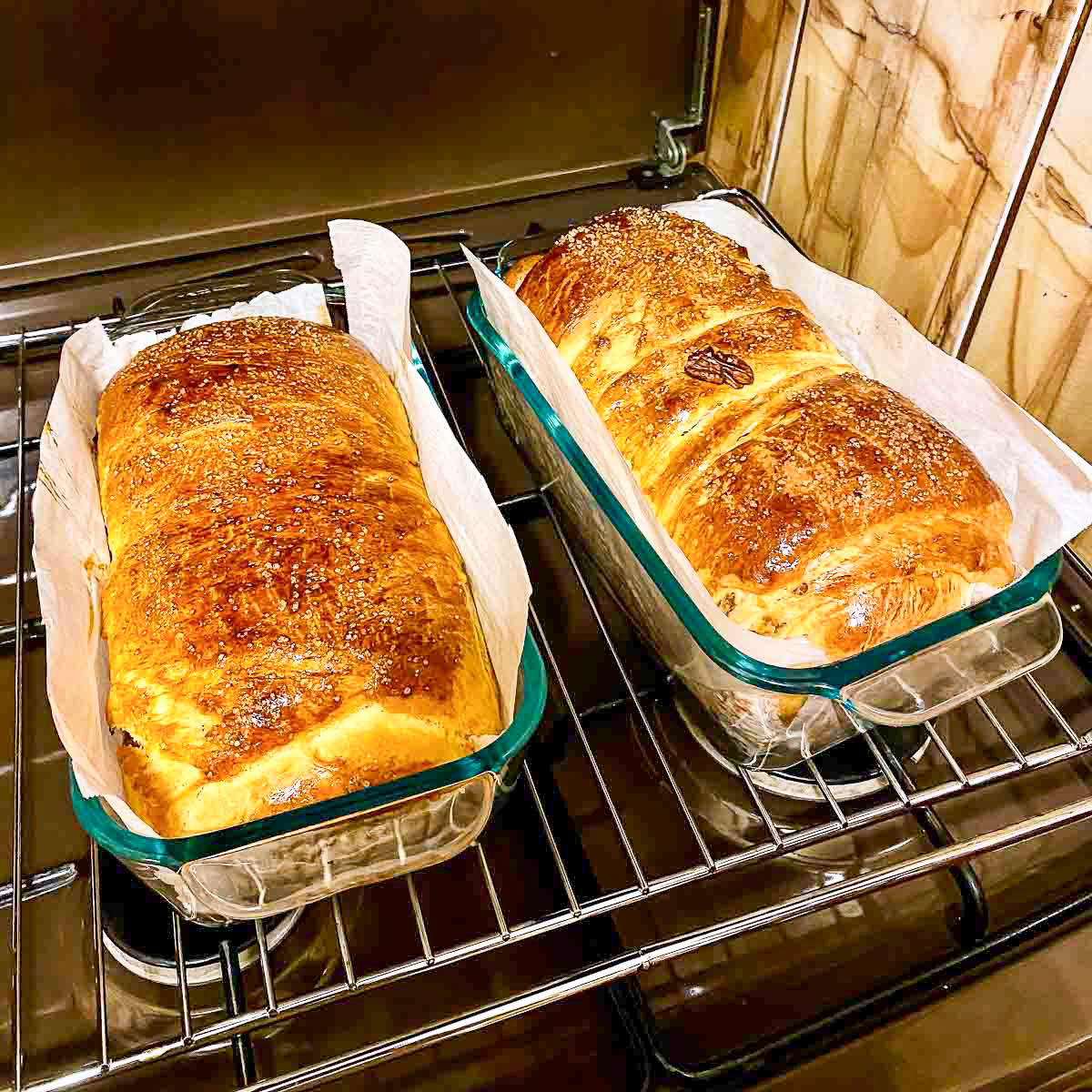
Your oven could be different; therefore, you might need to bake for another 5-10 minutes or less. Allow them to sit for 5 minutes before turning onto a wire rack to cool (this will take about 1 hour).
❄️ How to store this sweet bread with walnuts
- Room Temperature: Keep the bread wrapped in plastic wrap or in an airtight container for up to 3-4 days.
- Refrigerate: If storing longer, refrigerate it wrapped tightly for up to a week.
- Freezing: Cozonac can be frozen for up to 2 months. Wrap it tightly in plastic wrap and then in aluminum foil. Thaw overnight at room temperature when ready to eat.
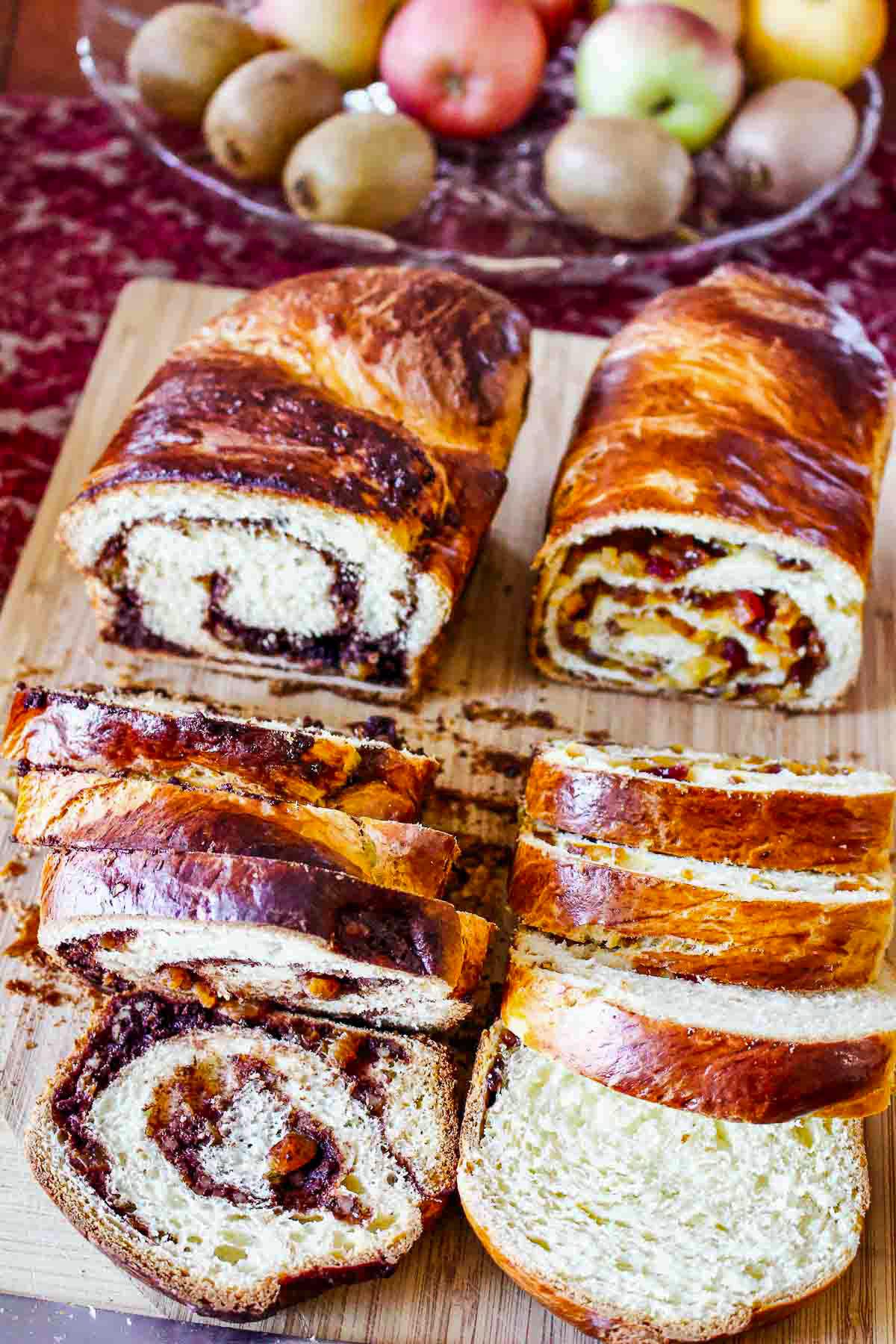
🍽️How to serve
- Serve this sweet bread with walnuts at room temperature, as it brings out the flavors and textures best.
- A slice of Cozonac goes perfectly with a cup of coffee or tea, especially for breakfast or as an afternoon snack.
- Consider lightly toasting slices and adding a bit of butter for a warm treat.
🙋♀️ Sweet Bread With Walnuts (Cozonac) Faqs
Yes, you can knead the dough by hand, but it will take more effort and time to achieve the right texture. My grandmother never had a mixer! :- )
The bread should be golden brown on top, and when tapped, it should sound hollow. An internal temperature of about 190°F (88°C) indicates it's fully baked.
Yes, you can prepare the dough and let it rise in the refrigerator overnight. This can actually enhance the flavor and texture of the bread.

🇷🇴 More Romanian Recipes To Love
📖 Recipe

Romanian Traditional Sweet Bread With Walnuts- Cozonac
Ingredients
For the dough:
- 2 tablespoons active dry yeast
- 2 cups whole milk
- 1 ¼ cups granulated sugar
- 5 egg yolks reserve the egg whites for the filling
- 8 cups all-purpose flour
- 1 cup unsalted butter room temperature (or ¾ cup neutral oil, like sunflower oil,canola)
- 2 teaspoons vanilla extract
- Zest from 1 lemon
- 1 teaspoon of salt
- 1 egg beaten for brushing the loaves
- 2-3 tablespoons oil for oiling the table surface and the bowl
For the filling:
- 10 ounces ground walnuts
- 5 egg whites
- ¼ cup rum or 1 teaspoon rum flavor
- ½ cup raisins
- 1 cup granulated sugar
Instructions
Make the Starter:
- Warm up the milk to 110F/44C, add the sugar, and mix to dissolve. Add the yeast and set it aside in a warm, draft-free place for 5 minutes or until frothy.
- Add the lemon zest and vanilla.
Make the dough:
- Measure ¼ cup rum and add the raisins. Set aside until you are ready to make the filling.
- Separate the eggs. For the dough, we will use only the yolks. (The egg white will be used to make the filling.)
- In a small bowl, mix yolks with the salt. Salt is essential in baking. It enhances the taste of the final product. Also, in this case, the salt intensifies the color of the yolks, and the bread will have a slightly yellow, beautiful color. Set aside.
- Meanwhile, sift the flour and place it in a bowl of a stand mixer fitted with a dough hook. Start the mixer on low speed and add egg yolks. Mix slowly while you start adding the milk mixture.
- You will obtain a very soft, sticky dough. Continue to mix while you add the soft butter, little by little. Continue to knead at low speed for 6-8 minutes or until the dough is smooth, elastic, and not sticky anymore.
- Tip: If the mixer gets too hot, stop and let cool for 5-10 minutes, then knead again until you obtain the elastic dough.
- Lightly grease a medium bowl with a bit of oil, add the dough and turn to coat the dough in the oil. Cover with plastic wrap and set aside in a warm, draft-free place for 1 hour or until doubled in size. (according to the temperature in your kitchen, it might take longer)
Make the filling:
- Beat the egg whites frothy, add the sugar, and continue to beat to a soft peak. Fold the ground walnuts and the mixture of raisins and rum gently.
Assemble the loaves:
- Brush four loaf pans with melted butter to grease.
- Punch the center of the dough down with your fist and turn it onto a lightly oiled surface. Knead for 1-2 minutes or until reduced to its original volume.
- Divide the dough into four equal portions. Use a lightly oiled rolling pin to roll out a dough portion to an 8x10 inches(20 cm x 25 cm) rectangle.
- Sprinkle a quarter of the filling evenly over the dough. Starting from a long side, roll up the dough to form a log and enclose the filling. Repeat with the remaining dough portions and filling.
- Place each log into a 9x5 inches baking pan. Cover with a slightly damp kitchen towel and set aside in a warm place for 1 hour or until almost doubled in size.
- Preheat the oven to 350F/180C.
- Brush the tops of the loaves with the whisked egg and sprinkle with the raw sugar.
- Bake for 20 minutes. Reduce the temperature to 330F/170C and bake for a further 30 minutes or until cooked through and the loaves sound hollow when tapped on the top.
- Your oven could be different. Therefore, you might need to bake for another 5-10 minutes or less. Allow the bread to cool in the pan for 5 minutes before turning onto a wire rack to cool (this will take about 1 hour).
- Serve at room temperature, cut into slices and enjoy!
Notes
- Yeast Activation: Ensure your yeast is fresh and active for a good rise. Warm (not hot) milk helps activate the yeast.
- Kneading is Key: Proper kneading develops gluten, which gives Cozonac its texture. If using a mixer, don't overheat it.
- Room Temperature Ingredients: Bring eggs, butter, and milk to room temperature for a smoother dough.
- Weigh for Precision: Use a kitchen scale. Precise measurements are crucial in baking for consistent results.
- Dough Consistency: The dough should be soft and slightly sticky. If it's too dry, add a bit of milk.
- Rising Time: Allow the dough enough time to double in size. This could take longer in cooler temperatures.
- Filling Proportions: Balance the amount of filling to dough – too much filling can make rolling and baking tricky.
- Oven Watch: Every oven is different. Start checking the Cozonac a bit earlier than stated, especially if your oven runs hot.
- Cooling: Let the Cozonac cool before slicing to maintain its structure.
Nutrition
This recipe was published in 2018 and republished in December 2023.

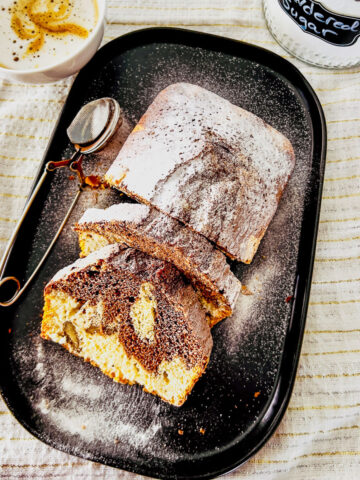





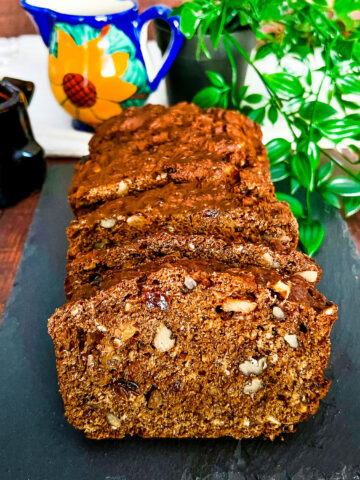

PaulaG says
I tried this recipe last night and it's just as I remember it as a child! Good job. Do you happen to have the recipe of the cheese filling to use with cozonac?
The Bossy Kitchen says
Hi Paula, So happy to hear you liked the recipe! While I don't have on the blog a recipe for Pasca, made with the cozonac dough, I have this recipe that is an easier version for it. https://www.thebossykitchen.com/easy-romanian-traditional-easter-cheesecake/ I hope it helps. Thank you for visiting and Happy Easter!
Lison says
I made this recipe yesterday. It was very good, not too sweet. I think I will omit raisins next time because my family didn't really enjoy them and the rum aroma.
A couple of things surprised me, the raw filling is very white and more on the batter side ( I maybe didn't whisk the egg whites enough, I use a manual whisk and was having a busy day) than on the paste side, if that makes sense. I usually make my family's poppy seed filled bread, and the filling is cooked on the stove.
The dough is sticky. I make bread around 3 times a week (all kinds) by hand. This dough took about 15 minutes to knead, which is pretty quick. I wouldn't recommend it to beginners who want to do it the traditional way.
Anyway, great recipe, not too sweet.
The Bossy Kitchen says
Hi Lison, Thank you for taking the time to write a review. The dough is sticky at the beginning, but during the kneading process it becomes less and less sticky and more elastic. You know it is done when it doesn't stick to your hands anymore. Sometimes, the kneading process takes a long time because of that and some people smack the dough against the table to insure enough air gets incorporated and the gluten develops. I use my Kitchen aid mixer for the kneading, as this activity made by hand never attracted me. I am glad you liked the fact that it is not sweet. I like it this way too. If you add fillings, the bread becomes sweet enough. We don't need a lot of sugar in our life anyway.:-) Thank you again for visiting.
Anna-Maija says
Hi!!
Thank you for a very nice recipe!!
I only had one problem and this is not the only time it happened with a cozonac.
I baked it for 90 min or so and it's getting dark on the outside but not cooked on the inside. I covered it with a tin foil.
Do you have any tips on why my cozonacs fail to cook through?
The Bossy Kitchen says
90 minutes is A LOT! However, the bread might be uncooked inside because the oven might be too hot and the outside of the bread cooks faster than the inside. This type of bread is rich in fats and sugar, and the sugar caramelizes faster. The bread catches color quicker and can burn faster.You need to check the temperature of your oven. I personally have an oven thermometer I bought online(very inexpensive) and I keep it inside the oven when I bake.
If the oven is running too high then you may need to turn it down slightly.If you have hot and cold spots inside the oven, you will have to rotate the breads while they bake.
It is a good idea to cover the breads with some foil if they burn on top, but lowering the temperature should also help.
Tatiana Popescu says
Hello! Did I miss the size of the baking tin? Thank you! Tatiana
The Bossy Kitchen says
You can use a 9.5x 5inches bread pan or 25x14 cm.
Tatiana Popescu says
Merci mult!
The Bossy Kitchen says
Cu placere!